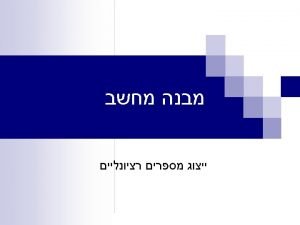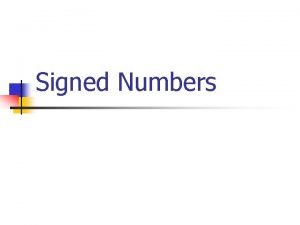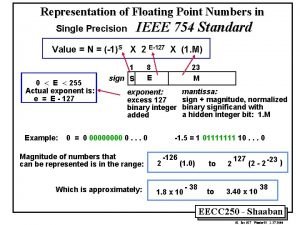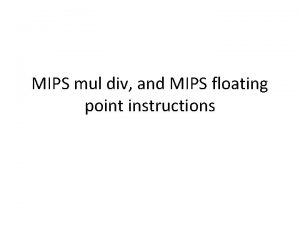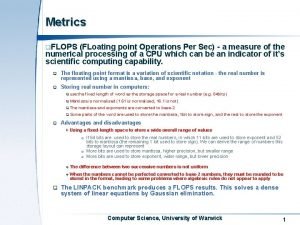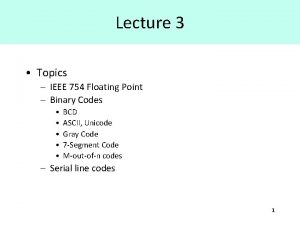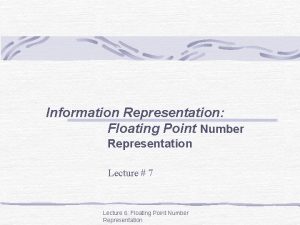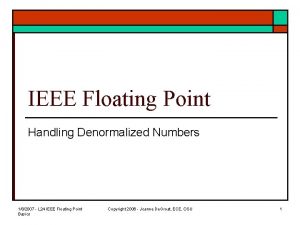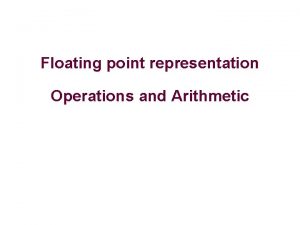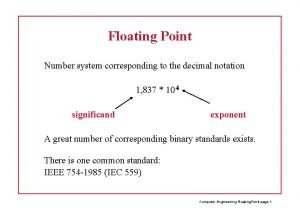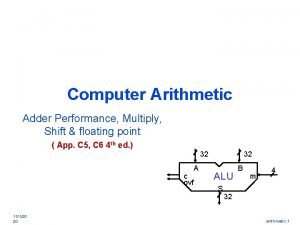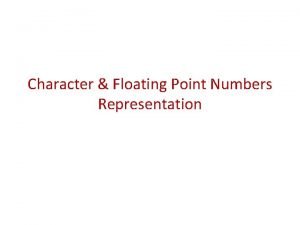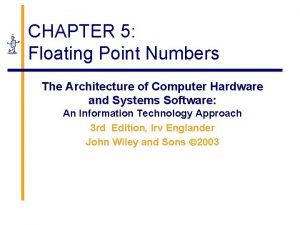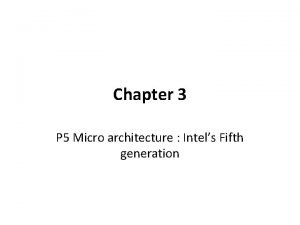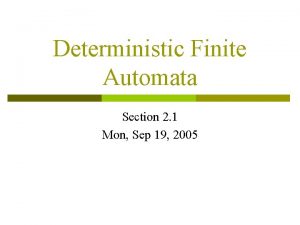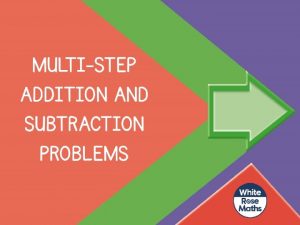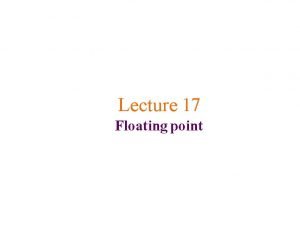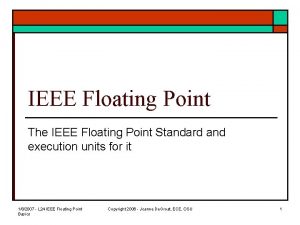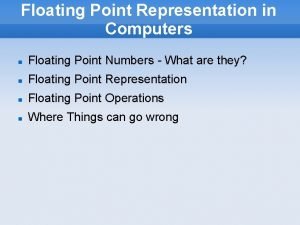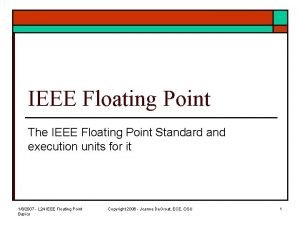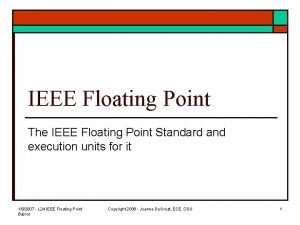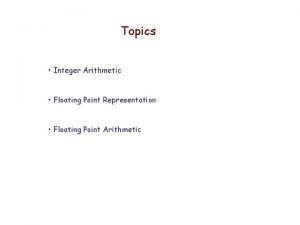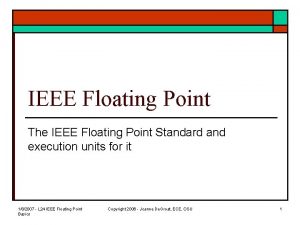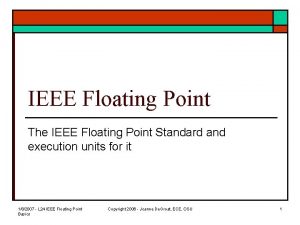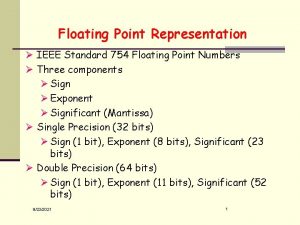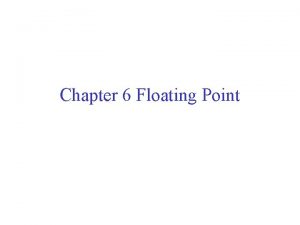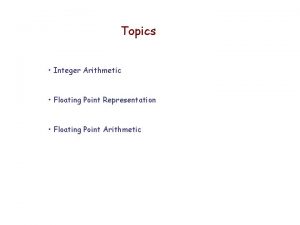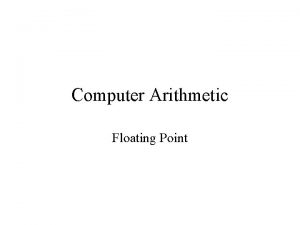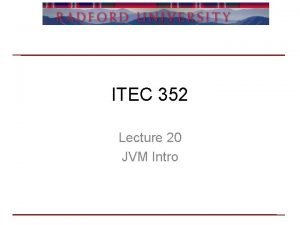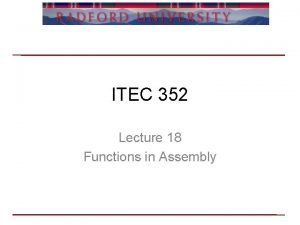ITEC 352 Lecture 8 Floating point format Review




![Why? • Consider class float. Test { public static void main(String[] args) { double Why? • Consider class float. Test { public static void main(String[] args) { double](https://slidetodoc.com/presentation_image/1c2feb153bb6477ddb33b88d7676ca41/image-5.jpg)













- Slides: 18

ITEC 352 Lecture 8 Floating point format

Review • Two’s complement • Excessive notation • Introduction to floating point Floating point numbers

Outline • Floating point conversion process Floating point numbers

Standards • What are the components that make up a floating point number? • How would you represent each piece in binary? Floating point numbers
![Why Consider class float Test public static void mainString args double Why? • Consider class float. Test { public static void main(String[] args) { double](https://slidetodoc.com/presentation_image/1c2feb153bb6477ddb33b88d7676ca41/image-5.jpg)
Why? • Consider class float. Test { public static void main(String[] args) { double x = 10; double y=Math. sqrt(x); y = y * y; if (x == y) System. out. println("Equal"); else System. out. println("Not equal"); } } Floating point numbers

Normalization 254 can be represented as: 2. 54 * 102 25. 4 * 101. 254 * 10 -1 There are infinitely many other ways, which creates problems when making comparisons, with so many representations of the same number. • Floating point numbers are usually normalized, in which the radix point is located in only one possible position for a given number. • Usually, but not always, the normalized representation places the radix point immediately to the left of the leftmost, nonzero digit in the fraction, as in: . 254 X 103. Floating point numbers

Example • Represent. 254 X 103 in a normalized base 8 floating point format with a sign bit, followed by a 3 -bit excess 4 exponent, followed by four base 8 digits. • Step #1: Convert to the target base. . 254 X 103 = 25410. Using the remainder method, we find that 25410 = 376 X 80: 254/8 = 31 R 6 31/8 = 3 R 7 3/8 = 0 R 3 • Step #2: Normalize: 376 X 80 =. 376 X 83. • Step #3: Fill in the bit fields, with a positive sign (sign bit = 0), an exponent of 3 + 4 = 7 (excess 4), and 4 -digit fraction =. 3760: 0 111. 011 110 000 Floating point numbers

Example Convert (9. 375 * 10 -2)10 to base 2 scientific notation • Start by converting from base 10 floating point to base 10 fixed point by moving the decimal point two positions to the left, which corresponds to the -2 exponent: . 09375. • Next, convert from base 10 fixed point to base 2 fixed point: . 09375 * 2 = 0. 1875 2 = 0. 375 * 2 = * . 375. 75 * 2 = 1. 0 0. 75 • Thus, (. 09375)10 = (. 00011)2. • Finally, convert to normalized base 2 floating point: Floating point numbers . 00011 =. 00011 * 20 = 1. 1 * 2 -4

IEEE 754 standard • Defines how to represent floating point numbers in 32 bit (single precision) and 64 bit (double precision). – 32 bit is the “float” type in java. – 64 bit is the “double” type in java. – The method: double. To. Long in Java displays the floating point number in IEEE standard. Floating point numbers

Consideration s • IEEE 754 standard also considers the following numbers: – Negative numbers. – Numbers with a negative exponent. • It also optimizes representation by normalizing the numbers and using the concept of hidden “ 1” Floating point numbers

Hidden “ 1” • What is the normalized representation of the following: 0. 00111 1. 00010 100 Floating point numbers

Hidden “ 1” • What is the normalized representation of the following: 0. 00111 = 1. 11 * 2 -3 1. 00010 = 1. 00 * 20 100 = 1. 00 * 22 Common theme: the digit to the left of the “. ” is always 1!! So why store this in 32 or 64 bits? This is called the hidden 1 representation. Floating point numbers

Negative thoughts • IEEE 754 representation uses the following conventions: – Negative significand – use sign magnitude form. – Negative exponent use excess 127 for single precision. Floating point numbers

IEEE-754 Floating Point Formats Floating point numbers

IEEE-754 Examples Floating point numbers

IEEE-754 Conversion Example • Represent -12. 62510 in single precision IEEE-754 format. • Step #1: Convert to target base. -12. 62510 = 1100. 1012 • Step #2: Normalize. -1100. 1012 = -1. 1001012 * 23 • Step #3: Fill in bit fields. Sign is negative, so sign bit is 1. Exponent is in excess 127 (not excess 128!), so exponent is represented as the unsigned integer 3 + 127 = 130. Leading 1 of significand is hidden, so final bit pattern is: 1 1000 0010. 1001 0100 0000 000 Floating point numbers

Binary coded decimals • Many systems still use decimal’s for computation, e. g. , older calculators. – Representation of decimals in such devices: • Use binary numbers to represent them (called Binary coded decimals) • BCD representation uses 4 digits. 0 = 0000 9 = 1001 Floating point numbers

Summary • IEEE floating point Floating point numbers
 Fixed point
Fixed point 01:640:244 lecture notes - lecture 15: plat, idah, farad
01:640:244 lecture notes - lecture 15: plat, idah, farad Floating point division algorithm in computer architecture
Floating point division algorithm in computer architecture Signed number range
Signed number range Floating point addition flowchart
Floating point addition flowchart Mult mips
Mult mips Floating point operations per seconds
Floating point operations per seconds Ieee 754 special cases
Ieee 754 special cases Floating point representation
Floating point representation Ieee denormalized numbers
Ieee denormalized numbers Floating point number representation
Floating point number representation Floating point representation
Floating point representation What are floating point numbers
What are floating point numbers Floating point 32 bit
Floating point 32 bit Eascii
Eascii Parts of a floating point number
Parts of a floating point number Branch prediction logic in pentium processor
Branch prediction logic in pentium processor Xkcd floating point
Xkcd floating point Dfa for floating point numbers
Dfa for floating point numbers
